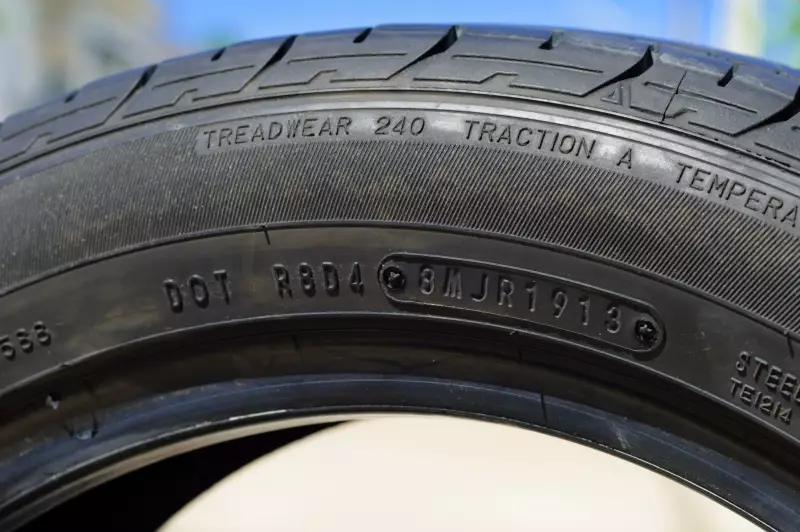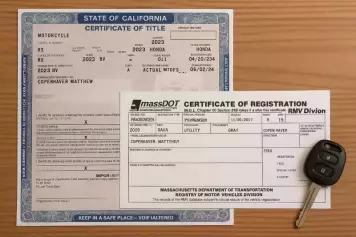Importing new cars and trucks was in full stride by the late 60s and early 70s. The Department of Transportation was just created in 1968, and one of its first priorities was to ensure the safety of America’s driving public by creating the DOT Tire Code in 1971.
Every tire, whether built or imported into the United States, is required by law to have the 13-digit alphanumeric DOT Tire Code stamped into the sidewall. This code is the forerunner to a host of additional regulations impacting the driving public, most notably the 17-digit VIN code required on every vehicle produced or imported into America, which was implemented in 1981.
Where Is The DOT Code Number On The Tire?
Every American tire is loaded with information so that each driver can get maximum performance and reliability from one of the most critical systems of their vehicle. The DOT requires numbers, such as the tire’s characteristics, various capacities, and construction, along with speed, inflation, and the DOT Tire Code.
The DOT Code, also referred to as the Tire Identification Number (TIN), is a series of letters and numbers indicating the tire’s compliance with the Department of Transportation’s performance and safety protocols.
The DOT/TIN code is located at the bead of the tire. The bead is a reinforced and robust section that sits directly above the wheel’s rim to create a seal under pressure. The nine to 13-digit alphanumeric code is heavily stamped into this area. The code will always begin with heavily stamped capital letters, DOT.

How To Read The DOT Code On Tires
The following is a typical DOT/TIN code stamped into every American-made or imported tire. Any tire that does not feature the DOT code does not meet the requirements of the Department of Transportation. Some tires have only a partial code stamped on one side of the tire, with the remainder stamped on the opposite sidewall.
Breaking Down Tire Identification Number
There is a great deal of flexibility when a tire manufacturer formats and imprints the code on their products.
- DOT: Indicates the manufacturer complies with all laws and regulations of the Department of Transportation.
Example: DOT 4B08 XYZ 3919
- Plant Code (2 characters): Shows the manufacturer's plant code. These letters or numbers describe where in the world the tire was made.
Example: 4B" = a specific factory location
- Size Code (2-3 characters): Shows the size of the tire. Characters two through four are often combined.
Example: "08"
- Model Code (2-4 characters): Indicates the type of tire and the manufacturer's model code of a specific product.
Example: "XYZ"
- Date Code (last 4 digits): Tells the date code. These numbers give the exact week and year the specific tire rolled off the assembly line.
Example: ‘’3919’’ means the manufacture date was the 39th week of 2019.
Tire Aging
Tire aging was a significant, but under-reported problem in the early 1990s until several high-profile SUV and truck rollovers began. The national uproar focused on stability issues with the Ford Explorer, rather than the fundamental problem of tire aging.
In 1985, Uniroyal voiced its concerns for the newly developed radial tires. A few short years later, the Explorer rollovers began, and it was later determined that tread separation at highway speeds directly contributed to lethal accidents.
Reports were sent to Congress, and the findings discovered that 84% of the accidents were related to tire aging. Climate and weather conditions contribute to tire aging. That’s why it’s important to know how long tires typically last- most should be replaced after about six years, even if they look fine.
Tire DOT Code Lookup
Vehicle owners need to know where the code is located and its importance. Drivers must understand the importance of the DOT Code on each one of their tires. The code ensures they are not buying outdated tires, and each tire is safe on the road.
Drivers should familiarize themselves with the DOT tire code and the markings to make sure there is no tire aging. Consult a mechanic or tire professional if you need help with the code.
The best website to use for a detailed explanation of the DOT Tire Code is the NHTSA. The DOT oversees eleven different federal agencies, including the NHTSA, which governs tire safety.
To find out how old your tires are and see details like the manufacturing date, you can use a tool like CheckTire.com. This site does away with a lot of the extraneous information and gets right to the age of the tire. Readouts from CheckTire give the user the exact date of manufacture along with the country where the tire was built.
The safety of you and your family is paramount, and making sure you are running on new tires will always keep you safe.




















